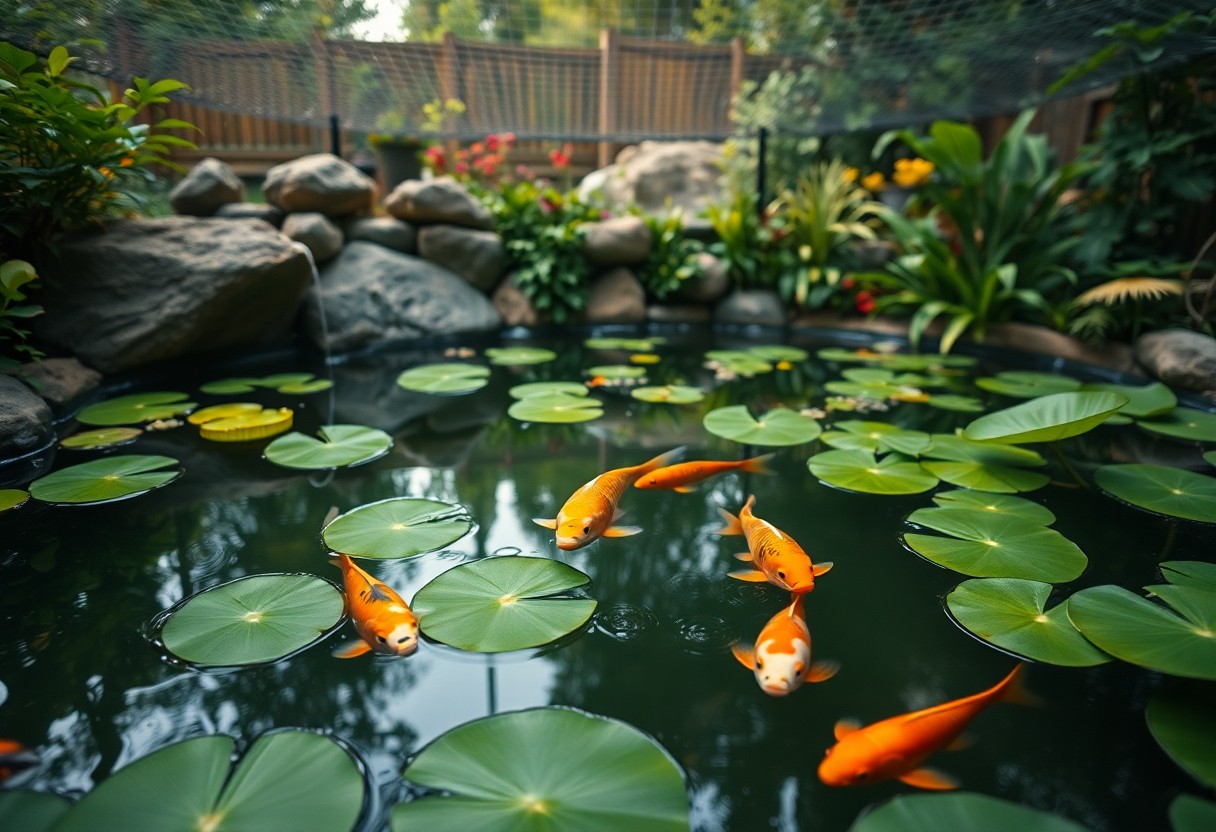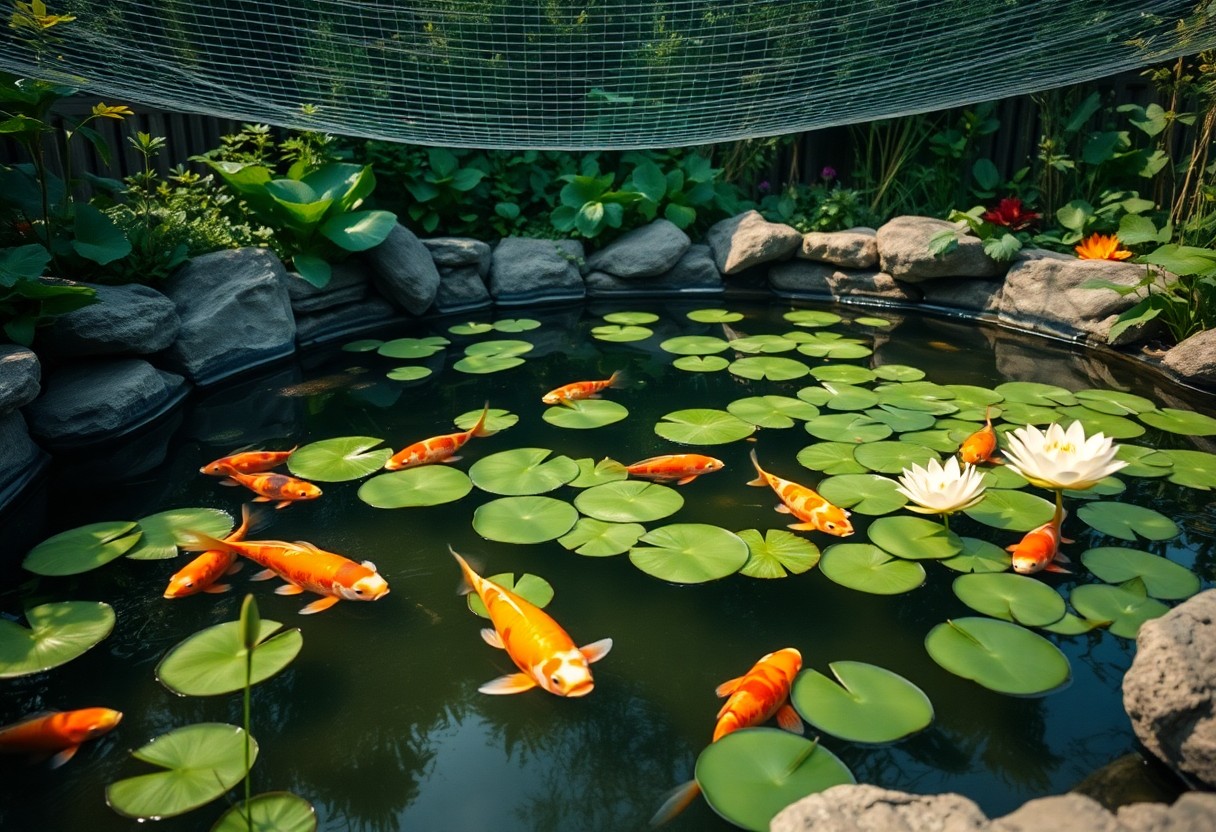Safety is paramount when it comes to ensuring your pond fish thrive in a protected environment. To safeguard your aquatic friends from predators like herons and raccoons, as well as pests such as mosquitoes and algae, you need to implement strategic measures that effectively deter these threats. In this guide, you’ll learn practical and actionable tips to create a safe haven for your fish, ensuring they grow healthy and lively while enjoying their tranquil habitat.
Table of Contents
Key Takeaways:
- Implement physical barriers like nets or wire mesh to deter larger predators such as birds and raccoons.
- Plant aquatic vegetation around the pond to provide shelter and hiding spots for fish, making it harder for predators to reach them.
- Introduce compatible pond companions like decoy fish or frogs to confuse and distract potential threats.
- Regularly monitor the pond environment and fish health to identify signs of pests or disease early on, allowing for timely intervention.
- Maintain water quality and a balanced ecosystem to keep fish healthy and less susceptible to stress and predation.
Understanding Common Pond Predators
For pond owners, it’s crucial to be aware of the various predators that threaten your fish. Knowing the types of predators in your area can help you take the necessary precautions to protect your aquatic friends. Each predator presents unique challenges and requires different strategies for keeping your pond fish safe. By being informed about these threats, you can create a safe environment for your pond inhabitants.
Aerial Threats (Birds and Flying Predators)
Common birds, such as herons, egrets, and even seagulls, can pose significant dangers to your pond fish. These aerial predators often stalk the water’s edge, waiting for the perfect moment to snatch fish from the surface. To combat this risk, consider implementing protection methods like decoys or covering parts of the pond with nets.
Ground-Based Predators (Raccoons, Cats, Foxes)
On land, various mammals like raccoons, cats, and foxes can become a threat to your pond fish. These cunning and agile predators often visit your pond at night, searching for an easy meal. Their stealthy approach means you may not even realize your fish are in danger until it’s too late.
Aerial threats primarily come in the form of large birds that can easily spot your fish from above. To deter these predators, consider installing a protective net or using floating decoys that mimic the presence of other birds. Additionally, planting tall vegetation around the pond can provide cover for your fish, making it more challenging for aerial predators to swoop in. Thoroughly understanding these threats is important for creating a safe environment for your pond fish.
Identifying Harmful Pond Pests
There’s a wide variety of harmful pests that can invade your pond and threaten the health of your fish. From tiny insects to larger predatory species, knowing how to identify these threats is imperative for maintaining a safe environment for your aquatic friends. Regular inspections of your pond will help you spot any unusual activity or signs of infestation early, allowing you to take appropriate action before the situation escalates.
Aquatic Insects and Parasites
To keep your pond fish safe, it’s imperative to identify harmful aquatic insects and parasites that can cause a variety of health issues. These pests, including mosquito larvae, leeches, and certain types of lice, can weaken your fish and even transmit diseases. Regular monitoring and prompt treatment will help ensure your fish remain healthy and vibrant.
Invasive Fish Species
Species like goldfish, bass, and carp can often outcompete native fish and disrupt the balance of your pond’s ecosystem. A single invasive species can lead to overcrowding, which will deplete oxygen levels and increase waste, harming your fish. It’s important to stay informed about potential invasive species in your area so you can take preventive measures to protect your pond and its inhabitants.
Physical Protection Methods
Not all predators can be deterred by simple strategies; implementing physical protection methods can significantly enhance the safety of your pond fish. These methods, including netting and barriers, create an effective shield against various threats. For further insights, check out How to keep predators from eating your fish? : r/ponds.
Installing Protective Netting
Protection for your fish can be easily achieved by installing protective netting over your pond. This net not only prevents birds and other aerial predators from snatching your fish but also keeps out leaves and debris, maintaining a healthier environment.
Setting Up Barrier Systems
An effective way to safeguard your pond fish is by setting up barrier systems around your pond. Barriers act as a deterrent, preventing land-based predators like raccoons and cats from accessing your fish.
To establish a barrier, you can utilize materials such as fencing or natural vegetation to safeguard your pond. Ensure that the barrier is at least three feet high to effectively deter climbing animals. Consider creating an incline at the base, making it challenging for predators to reach the water’s edge. Additionally, you might want to include a buried fence to prevent animals from digging under. This multi-layered approach significantly enhances your pond’s defense while ensuring your fish remain safe and protected.
Natural Deterrent Solutions
After establishing a pond, implementing natural deterrent solutions effectively reduces predatory threats and pest issues, creating a safer environment for your fish. Using plants and design features can significantly enhance the complexity of the ecosystem, making it less accessible for common predators while promoting a thriving aquatic habitat.
Plant Coverage and Hiding Spots
You can enhance your pond’s defenses by incorporating various aquatic and marginal plants. Dense vegetation offers both coverage and hiding spots for your fish, making it challenging for predators such as herons or raccoons to spot them. Strategically placed plants like water lilies and reeds not only provide shelter but also improve your pond’s overall aesthetics.
Water Depth and Bank Design
To keep your pond fish safe, focus on the water depth and bank design. By ensuring your pond has a varying depth, you offer fish places to retreat and hide. Shallow areas can promote vegetation growth while deeper regions provide safety from aerial and shore-based predators. A well-designed bank with sloping edges rather than steep walls allows fish to quickly escape encounters with threats.
Plant shrubs and rocks along the banks to add further complexity to the environment. Shallow edges enable your fish to stay close to the surface, while deeper zones give them refuge during predator attacks. Keeping your pond’s layout diverse, with varying depths and natural barriers, not only creates a more engaging habitat but also successfully minimizes risk factors for your fish.

Electronic and Mechanical Solutions
To safeguard your pond fish from predators, consider various electronic and mechanical solutions. Devices like motion-activated sprinklers or noise-making gadgets can help keep them at bay. For detailed options, you can Protect Your Fish from Pond Predators, ensuring they can thrive without constant fear.
Motion-Activated Deterrents
There’s a variety of motion-activated deterrents that can effectively scare away unwanted visitors from your pond. These devices detect movement and emit sounds or sprays of water, making your fish habitat less inviting to predators like herons or raccoons.
Lighting and Alarm Systems
Deterrents such as lighting and alarm systems can also help in preserving your fish’s safety. Utilizing bright, strategically placed lights can deter nocturnal predators, while alarm systems alert you to any disturbances.
This strategy allows for constant vigilance regarding your pond’s safety. Installing motion-activated lights can illuminate the area during darkness, discouraging predators from approaching. Coupling this with a reliable alarm system will notify you of potential threats, allowing for timely intervention before harm comes to your fish. Together, these measures form a solid defense against common pond threats.
Preventive Maintenance Tips
Now, to enhance the safety of your pond, regular *preventive maintenance* is imperative. This includes:
- Ensuring adequate pond depth to deter predators
- Installing protective netting over the pond
- Maintaining water quality regularly
- Checking for any signs of infestation or damage
- Providing hiding spots for fish using rocks and plants
Any proactive measures you establish may greatly reduce the risk of harm to your fish.
Regular Monitoring Practices
Preventive actions include regular monitoring of your pond’s dynamics. Check the behavior of your fish routinely and observe any unusual patterns or signs of distress. Keep an eye on predator activity around your pond and take note of environmental changes that may impact your fish’s safety. This constant vigilance helps you swiftly address any issues that arise, safeguarding your aquatic friends.
Seasonal Protection Adjustments
An important aspect of keeping your fish safe is adjusting your protective measures according to the changing seasons. You may need to enhance your predator deterrents in spring and summer when birds and animals are more active. Conversely, during colder months, consider providing additional shelter or heating sources to keep your fish secure and healthy.
With the changing seasons, your pond requires tailored adjustments for optimal fish protection. In spring, when predators like herons are more prevalent, investing in netting becomes vital to shield your fish. Summer brings about a higher chance of algae blooms, which can harm your fish—consider adding aerators. As temperatures drop in autumn, ensure your fish have warm shelter and de-icing equipment to prevent freezing. Each seasonal shift demands your attention to maintain the health and safety of your pond’s ecosystem.
Final Words
Now that you understand the various methods to keep your pond fish safe from predators and pests, it’s time to put these strategies into action. By employing protective measures such as netting, plant cover, and proper pond maintenance, you can create a secure environment for your fish. Additionally, being vigilant about the presence of raccoons, herons, and other threats will help you take timely actions. With the right approach, you can ensure your aquatic pets thrive while minimizing losses to predators. Invest the effort now for a vibrant, healthy pond ecosystem in the future.
FAQ
Q: What are some common predators of pond fish?
A: Common predators that pose a threat to pond fish include herons, kingfishers, raccoons, cats, and larger fish such as pike or bass. Each of these can easily access your pond and attempt to catch small fish, making it important to have protective measures in place.
Q: How can I physically protect my pond from birds like herons?
A: To protect your pond from birds such as herons, you can install netting or overhead structures to create barriers that prevent access. Floating plants and cover can also provide hiding spots for fish. Adding decoys, like a plastic heron, may deter real ones, as they may perceive the area as occupied.
Q: What types of plants can help keep pond fish safe?
A: Keeping aquatic plants in your pond, such as water lilies, hornwort, and cattails, can provide shelter for fish from predators. These plants can create hiding spots and reduce visibility, ensuring that your fish have nearby cover to evade threats.
Q: Are there any preventive measures against pests like leeches or snails that harm pond fish?
A: To manage pests such as leeches or snails, consider introducing natural predators like goldfish or certain types of minnows that feed on these unwanted visitors. Regular maintenance of the pond, such as removing excess debris and controlling algae, can also help minimize pest populations that can endanger your fish.
Q: What role do water temperatures play in keeping pond fish safe?
A: Maintaining optimal water temperatures is vital for the health of pond fish. Extreme temperatures can stress fish, making them more susceptible to disease and predation. Regular monitoring of water conditions and ensuring that your pond is well-aerated and shaded can create a healthier environment that promotes fish safety and vitality.

